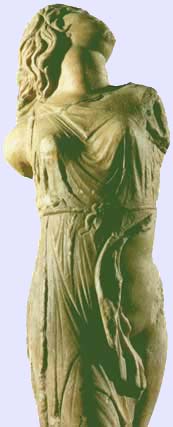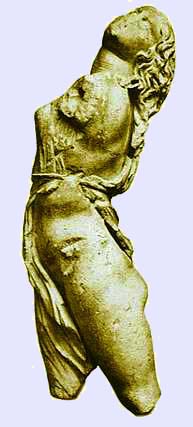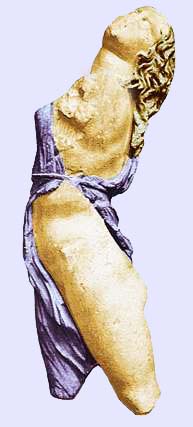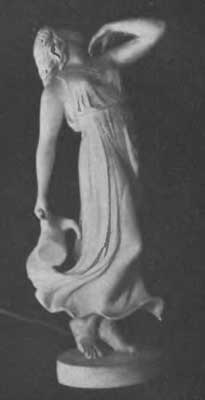.
Griechische Kunst: Tanzende Mänade des Skopas
Skopas, as if moved by some inspiration, imparted to the making of his statue the divine frenzy that possessed him. Why should I not describe to you from the beginning the inspiration of this work of art? The statue of a Maenad, wrought from Parian marble, has been transformed into a real Maenad. For the stone, while retaining its own nature, yet seemed to depart from the law which governs stone; what one saw was really an image, but art carried imitation over into actual reality. You would have seen that, hard as it was, it became soft to resemble the feminine, though its vigor corrected the femininity, and that, though it lacked the power to move, it knew how to dance in Bacchic frenzy, responding to the god as he entered within. When we saw her face we stood speechless, so clear upon it was the evidence of sense perception, though perception was not present; so clear was the intimation of Bacchic divine possession stirring Bacchic frenzy, though no such possession aroused it; and as many signs of passion that a soul goaded by divine madness displays, these blazed out from it, fashioned by art in fashion indescribable. The hair fell free to be tossed by the wind, and was divided to show the glory of each strand; this most of all transcended reason, since, stone though the material was, it obeyed the lightness of hair and yielded to imitation of its tresses, and though void of life's vitality it was vital withal. Indeed you might say that art has harnessed the impulses of growth, so unbelievable is what you see, so visible is what you do not believe. It actually even showed hands in motion?for it was not waving the Bacchic thyrsos, but carried a victim as if crying "Euoi"!?sign of a more poignant madness. And the figure of the kid was livid in color, and the stone took on the appearance of dead flesh; and though the material was one and the same, it severally imitated life and death... Kallistratos, Descriptions of Statues 2.1-4 (work of 3rd or 4th century A.D.)




One Reconstruction
The Maenad of Skopas, c. 340 BC, Roman copy. Skopas (or Scopas) of Paros, produced around thirty statues distributed in Greece proper and on the coast of Asia Minor, architect of a temple of Athena at Tegea in Arcadia which was built to replace one destroyed by fire in 395-4. He as active as late as the middle of the century, being one of four sculptors engaged on the reliefs of the Mausoleum or funeral monument of Maussollus, satrap of Caria. Statues all representing divinities or other imaginary beings mentioned in literature but only the Maenad statue survived.
| Ancient Greece
Science, Technology , Medicine , Warfare, , Biographies , Life , Cities/Places/Maps , Arts , Literature , Philosophy ,Olympics, Mythology , History , Images Medieval Greece / Byzantine Empire Science, Technology, Arts, , Warfare , Literature, Biographies, Icons, History Modern Greece Cities, Islands, Regions, Fauna/Flora ,Biographies , History , Warfare, Science/Technology, Literature, Music , Arts , Film/Actors , Sport , Fashion --- |

